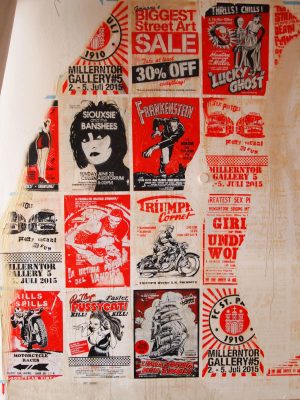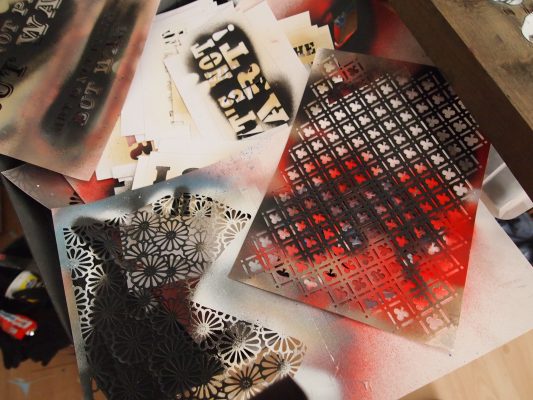Interview
Interview: Andreas Jakobs
In conversation with artist Hamburg based stencil artist Andreas Jakobs.
Can you talk about your journey into or interest the arts?
My desire to be creative has always been there. My interest in street art, especially stencil, was sparked when I worked as a graphic slave in an advertising agency in the early 2000s. I had a room in the famous trendy district of Hamburg – ‘Schanze’.
There was a paste-up next to the entrance to my apartment and I was immediately fascinated by the technique. I wanted to do that too. I later found out that the paste-up was made by the Berlin artist Alias. But it took me a while to quit my job and decided to be a full-time artist.
Do you use a sketchbook? I’m interested in what a sketchbook means to you and your work?, or how people develop their ideas.
I don’t really have a sketchbook. I have a small black notebook and quite a few loose pieces of paper with scribbles. A bit messy.
In the book i write down ideas and thoughts. On my computer I have a digital mood board for visual ideas.
Some of my ideas I immediately realize and some are composed out of the fragments from my book, my scribbles and the collected images.
You describe yourself as a stencil artist, can you elaborate on this, what defines it, the conventions and rules etc?
There are no rules. Everyone does art the way they want. It makes no difference whether you work with a pen, brush or spray can. Everyone chooses their tool, depending on what they are good at. I am good at cutting stencils.
There is an urban nature to your work, can you elaborate on your influences and interests?
I want my pictures to have something of a dirty urban wall. Perhaps it is the picture of this first paste-up that drives me. I always have that in mind.
What inspires me? Of course, I am influenced by graphic design, such as the aesthetics of propaganda posters. But I reverse their message just like I do with the mechanisms of advertising. They can be found in my picture ideas and statements, in a sarcastic exaggerated way.
I grew up in a time and place where apart from punk there was little opportunity to differ from others. Therefore punk is also an important inspiration regarding the message, the impression and the dirt.
Can you talk about your process of working. How do you work, how often, is there a particular pattern?
There is no ‘normal’ process in the creation of my pictures. The ideas arise in different ways.
However, the implementation is usually like this. First I create an illustration on the computer, then I cut the stencil, often making small changes then. When all layers are finished, which can be up to 20 pieces, I start to build the frame for the picture. I usually use old timber for this. The background of the picture is decisive for the dirty look therefore I take extra time for this. Then finally I start spraying.
Do you find the process of creating work relaxing or therapeutic? I’ve become increasingly interested in the relationship of the sketchbook and the work to the artist.
Cutting stencils is very meditative. This is my yoga.












Do you like this artist?
If so, why not write a comment or share it to your social media. Thanks in advance if you can help in this way.